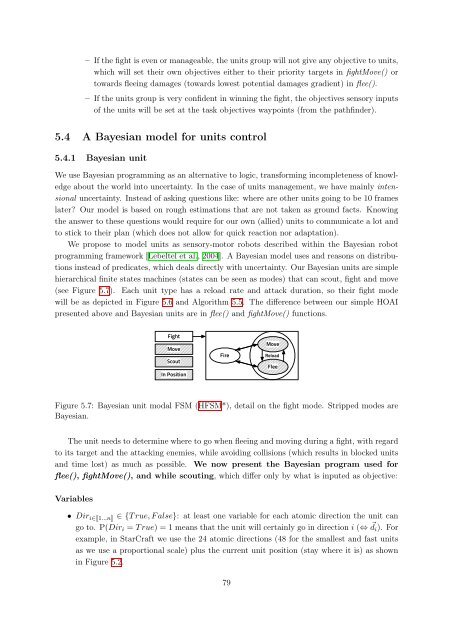Bayesian Programming and Learning for Multi-Player Video Games ...
Bayesian Programming and Learning for Multi-Player Video Games ...
Bayesian Programming and Learning for Multi-Player Video Games ...
Create successful ePaper yourself
Turn your PDF publications into a flip-book with our unique Google optimized e-Paper software.
– If the fight is even or manageable, the units group will not give any objective to units,<br />
which will set their own objectives either to their priority targets in fightMove() or<br />
towards fleeing damages (towards lowest potential damages gradient) in flee().<br />
– If the units group is very confident in winning the fight, the objectives sensory inputs<br />
of the units will be set at the task objectives waypoints (from the pathfinder).<br />
5.4 A <strong>Bayesian</strong> model <strong>for</strong> units control<br />
5.4.1 <strong>Bayesian</strong> unit<br />
We use <strong>Bayesian</strong> programming as an alternative to logic, trans<strong>for</strong>ming incompleteness of knowledge<br />
about the world into uncertainty. In the case of units management, we have mainly intensional<br />
uncertainty. Instead of asking questions like: where are other units going to be 10 frames<br />
later? Our model is based on rough estimations that are not taken as ground facts. Knowing<br />
the answer to these questions would require <strong>for</strong> our own (allied) units to communicate a lot <strong>and</strong><br />
to stick to their plan (which does not allow <strong>for</strong> quick reaction nor adaptation).<br />
We propose to model units as sensory-motor robots described within the <strong>Bayesian</strong> robot<br />
programming framework [Lebeltel et al., 2004]. A <strong>Bayesian</strong> model uses <strong>and</strong> reasons on distributions<br />
instead of predicates, which deals directly with uncertainty. Our <strong>Bayesian</strong> units are simple<br />
hierarchical finite states machines (states can be seen as modes) that can scout, fight <strong>and</strong> move<br />
(see Figure 5.7). Each unit type has a reload rate <strong>and</strong> attack duration, so their fight mode<br />
will be as depicted in Figure 5.6 <strong>and</strong> Algorithm 5.5. The difference between our simple HOAI<br />
presented above <strong>and</strong> <strong>Bayesian</strong> units are in flee() <strong>and</strong> fightMove() functions.<br />
Fight<br />
Move<br />
Scout<br />
In Position<br />
Fire<br />
Figure 5.7: <strong>Bayesian</strong> unit modal FSM (HFSM*), detail on the fight mode. Stripped modes are<br />
<strong>Bayesian</strong>.<br />
The unit needs to determine where to go when fleeing <strong>and</strong> moving during a fight, with regard<br />
to its target <strong>and</strong> the attacking enemies, while avoiding collisions (which results in blocked units<br />
<strong>and</strong> time lost) as much as possible. We now present the <strong>Bayesian</strong> program used <strong>for</strong><br />
flee(), fightMove(), <strong>and</strong> while scouting, which differ only by what is inputed as objective:<br />
Variables<br />
• Dir i∈�1...n� ∈ {T rue, F alse}: at least one variable <strong>for</strong> each atomic direction the unit can<br />
go to. P(Diri = T rue) = 1 means that the unit will certainly go in direction i (⇔ � di). For<br />
example, in StarCraft we use the 24 atomic directions (48 <strong>for</strong> the smallest <strong>and</strong> fast units<br />
as we use a proportional scale) plus the current unit position (stay where it is) as shown<br />
in Figure 5.2.<br />
79<br />
Move<br />
Reload<br />
Flee


